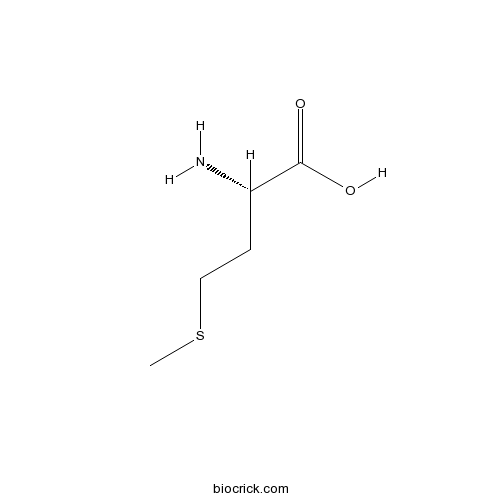H-Met-OHCAS# 63-68-3 |

- H-D-Met-OH
Catalog No.:BCC2997
CAS No.:348-67-4
- DL-Methionine
Catalog No.:BCC8318
CAS No.:59-51-8
Quality Control & MSDS
3D structure
Package In Stock
Number of papers citing our products

| Cas No. | 63-68-3 | SDF | Download SDF |
| PubChem ID | 6137 | Appearance | White powder |
| Formula | C5H11NO2S | M.Wt | 149.2 |
| Type of Compound | Nitrogen-containing Compounds | Storage | Desiccate at -20°C |
| Synonyms | L-methionine; 63-68-3; Methionine | ||
| Solubility | H2O : 16.67 mg/mL (111.72 mM; Need ultrasonic) | ||
| Chemical Name | (2S)-2-amino-4-methylsulfanylbutanoic acid | ||
| SMILES | CSCCC(C(=O)O)N | ||
| Standard InChIKey | FFEARJCKVFRZRR-BYPYZUCNSA-N | ||
| Standard InChI | InChI=1S/C5H11NO2S/c1-9-3-2-4(6)5(7)8/h4H,2-3,6H2,1H3,(H,7,8)/t4-/m0/s1 | ||
| General tips | For obtaining a higher solubility , please warm the tube at 37 ℃ and shake it in the ultrasonic bath for a while.Stock solution can be stored below -20℃ for several months. We recommend that you prepare and use the solution on the same day. However, if the test schedule requires, the stock solutions can be prepared in advance, and the stock solution must be sealed and stored below -20℃. In general, the stock solution can be kept for several months. Before use, we recommend that you leave the vial at room temperature for at least an hour before opening it. |
||
| About Packaging | 1. The packaging of the product may be reversed during transportation, cause the high purity compounds to adhere to the neck or cap of the vial.Take the vail out of its packaging and shake gently until the compounds fall to the bottom of the vial. 2. For liquid products, please centrifuge at 500xg to gather the liquid to the bottom of the vial. 3. Try to avoid loss or contamination during the experiment. |
||
| Shipping Condition | Packaging according to customer requirements(5mg, 10mg, 20mg and more). Ship via FedEx, DHL, UPS, EMS or other couriers with RT, or blue ice upon request. | ||

H-Met-OH Dilution Calculator

H-Met-OH Molarity Calculator
| 1 mg | 5 mg | 10 mg | 20 mg | 25 mg | |
| 1 mM | 6.7024 mL | 33.5121 mL | 67.0241 mL | 134.0483 mL | 167.5603 mL |
| 5 mM | 1.3405 mL | 6.7024 mL | 13.4048 mL | 26.8097 mL | 33.5121 mL |
| 10 mM | 0.6702 mL | 3.3512 mL | 6.7024 mL | 13.4048 mL | 16.756 mL |
| 50 mM | 0.134 mL | 0.6702 mL | 1.3405 mL | 2.681 mL | 3.3512 mL |
| 100 mM | 0.067 mL | 0.3351 mL | 0.6702 mL | 1.3405 mL | 1.6756 mL |
| * Note: If you are in the process of experiment, it's necessary to make the dilution ratios of the samples. The dilution data above is only for reference. Normally, it's can get a better solubility within lower of Concentrations. | |||||

Calcutta University

University of Minnesota

University of Maryland School of Medicine

University of Illinois at Chicago

The Ohio State University

University of Zurich

Harvard University

Colorado State University

Auburn University

Yale University

Worcester Polytechnic Institute

Washington State University

Stanford University

University of Leipzig

Universidade da Beira Interior

The Institute of Cancer Research

Heidelberg University

University of Amsterdam

University of Auckland

TsingHua University

The University of Michigan

Miami University

DRURY University

Jilin University

Fudan University

Wuhan University

Sun Yat-sen University

Universite de Paris

Deemed University

Auckland University

The University of Tokyo

Korea University
H-Met-OH
- Primaquine Diphosphate
Catalog No.:BCC4706
CAS No.:63-45-6
- Androstenedione
Catalog No.:BCC8296
CAS No.:63-05-8
- Staurosporine
Catalog No.:BCC3612
CAS No.:62996-74-1
- 6-Aminoquinoxaline
Catalog No.:BCC8767
CAS No.:6298-37-9
- XL335
Catalog No.:BCC4501
CAS No.:629664-81-9
- Boc-Tle-OH
Catalog No.:BCC3343
CAS No.:62965-35-9
- Gnetucleistol D
Catalog No.:BCN3400
CAS No.:629643-26-1
- Gomisin G
Catalog No.:BCN2269
CAS No.:62956-48-3
- Gomisin F
Catalog No.:BCN3625
CAS No.:62956-47-2
- (2-Benzothiazolylthio)acetic acid
Catalog No.:BCC8387
CAS No.:6295-57-4
- 6-Methoxy-4-methylcoumarin
Catalog No.:BCN6537
CAS No.:6295-35-8
- Morusinol
Catalog No.:BCN4168
CAS No.:62949-93-3
- Sulfanilamide
Catalog No.:BCC4858
CAS No.:63-74-1
- L-Phenylalanine
Catalog No.:BCN3818
CAS No.:63-91-2
- Phenoxybenzamine HCl
Catalog No.:BCC4334
CAS No.:63-92-3
- Nonacosane
Catalog No.:BCC9102
CAS No.:630-03-5
- Ouabain
Catalog No.:BCC5069
CAS No.:630-60-4
- Phenytoin sodium
Catalog No.:BCC5071
CAS No.:630-93-3
- Corynoxeine
Catalog No.:BCN5002
CAS No.:630-94-4
- Neoprzewaquinone A
Catalog No.:BCN4169
CAS No.:630057-39-5
- MRS 2500 tetraammonium salt
Catalog No.:BCC5881
CAS No.:630103-23-0
- PD 168077 maleate
Catalog No.:BCC6919
CAS No.:630117-19-0
- AST 487
Catalog No.:BCC1373
CAS No.:630124-46-8
- Androstenone hydrazone
Catalog No.:BCC8830
CAS No.:63015-10-1
Inhibitors of tripeptidyl peptidase II. 2. Generation of the first novel lead inhibitor of cholecystokinin-8-inactivating peptidase: a strategy for the design of peptidase inhibitors.[Pubmed:10691692]
J Med Chem. 2000 Feb 24;43(4):664-74.
The cholecystokinin-8 (CCK-8)-inactivating peptidase is a serine peptidase which has been shown to be a membrane-bound isoform of tripeptidyl peptidase II (EC 3.4.14.10). It cleaves the neurotransmitter CCK-8 sulfate at the Met-Gly bond to give Asp-Tyr(SO(3)H)-Met-OH + Gly-Trp-Met-Asp-Phe-NH(2). In seeking a reversible inhibitor of this peptidase, the enzymatic binding subsites were characterized using a fluorimetric assay based on the hydrolysis of the artificial substrate Ala-Ala-Phe-amidomethylcoumarin. A series of di- and tripeptides having various alkyl or aryl side chains was studied to determine the accessible volume for binding and to probe the potential for hydrophobic interactions. From this initial study the tripeptides Ile-Pro-Ile-OH (K(i) = 1 microM) and Ala-Pro-Ala-OH (K(i) = 3 microM) and dipeptide amide Val-Nvl-NHBu (K(i) = 3 microM) emerged as leads. Comparison of these structures led to the synthesis of Val-Pro-NHBu (K(i) = 0.57 microM) which served for later optimization in the design of butabindide, a potent reversible competitive and selective inhibitor of the CCK-8-inactivating peptidase. The strategy for this work is explicitly described since it illustrates a possible general approach for peptidase inhibitor design.


